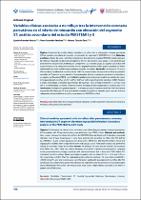| dc.contributor.author | Paredes Paucar, Cynthia | |
| dc.contributor.author | Custodio Sánchez, Piero | |
| dc.contributor.author | Chacón Diaz, Manuel | |
| dc.date.accessioned | 2023-05-29T20:57:53Z | |
| dc.date.available | 2023-05-29T20:57:53Z | |
| dc.date.issued | 2022-12-31 | |
| dc.identifier.citation | Archivos Peruanos de Cardiología y Cirugía Cardiovascular. 2022; 3(4). | es_PE |
| dc.identifier.issn | 2708-7212 | |
| dc.identifier.uri | https://hdl.handle.net/20.500.12959/3747 | |
| dc.description.abstract | Objetivo. Determinar las variables clínicas asociados a no reflujo tras la intervención coronaria percutánea (ICP) en pacientes con infarto de miocardio con elevación del segmento ST (IAMCEST) en el Perú. Materiales y métodos. Estudio de casos y controles retrospectivo, derivado de los registros PERSTEMI (registro peruano de infarto de miocardio con elevación del segmento ST) I y II. Se consideró casos (grupo 1) a los pacientes que presentaron no reflujo tras la ICP, definido porun flujo TIMI<3, y controles (grupo2) a aquellos con un flujoTIMI 3 post intervención. Se compararon variables clínicas y angiográficas entre ambos grupos y se realizó un análisis multivariable buscando variables independientes asociados a no reflujo. Resultados. Se incluyeron 75 casos y 304 controles. La incidencia de no reflujo fue del 19,8%. Se presentó mayor frecuencia de no reflujo en pacientes sometidos a ICP primaria en comparación a farmacoinvasiva, además en pacientes con lesiones uniarteriales y en aquellos con flujo inicial TIMI 0. La mortalidad hospitalaria y la incidencia de insuficiencia cardiaca fue mayor en los pacientes con no reflujo (21,3% vs. 2,9% y 45,3% vs. 16,5%, respectivamente, valor de p < 0,001). Posterior al análisis multivariado se encontró que el tiempo de isquemia > 12 h, un Killip Kimball (KK) > I, un flujo inicial TIMI 0, y la enfermedad uniarterial, fueron las variables asociadas de forma significativa a no reflujo tras la ICP. Conclusiones. El tiempo de isquemia mayor a 12 h, el mayor puntaje KK, la presencia de flujo TIMI 0 en la arteria responsable del infarto pre-ICP y la enfermedad coronaria uniarterial son variables que se asocian de forma independiente la posibilidad de no reflujo en pacientes con IAMCEST en el Perú. | es_PE |
| dc.description.abstract | Objective. To determine the clinical factors associated to no-reflow after percutaneous coronary intervention (PCI) in patients with ST-segment elevation myocardial infarction (STEMI) in Peru. Methods. Case - control retrospective study, derived from the PERSTEMI (Peruvian Registry of ST-elevation myocardial infarction) I and II. Cases (group 1) were those patients who presented no-reflow after PCI, defined by a TIMI flow < 3, and controls (group 2) were those with a TIMI 3 flow after the intervention. Clinical and angiographic variables were compared between both groups, and a multivariate analysis was performed looking for associated factors to no-reflow. Results. We included 75 cases and 304 controls. The incidence of no-reflow was 19.8%. There was a higher frequency of no-reflow in patients with primary PCI compared to the pharmacoinvasive strategy, in patients with one-vessel disease and in those with TIMI 0 before PCI. In-hospital mortality and heart failure were higher in patients with no-reflow (21.3% vs. 2.9% and 45.3% vs. 16.5, respectively; p<0.001). After multivariate analysis, the ischemic time > 12 hours, Killip Kimball (KK) > I, TIMI 0 before PCI, and one-vessel disease were the factors significantly associated with no-reflow after PCI. Conclusions. The ischemic time greater than 12 hours, the highest KK score, the presence of an occluded culprit artery (TIMI 0) before PCI and an one-vessel disease, were factors independently associated with no-reflow in patients with STEMI in Peru | es_PE |
| dc.format | application/pdf | es_PE |
| dc.language.iso | spa | es_PE |
| dc.language.iso | eng | es_PE |
| dc.publisher | Instituto Nacional Cardiovascular - INCOR | es_PE |
| dc.relation.uri | https://apcyccv.org.pe/index.php/apccc/article/view/253 | es_PE |
| dc.rights | info:eu-repo/semantics/openAccess | es_PE |
| dc.rights.uri | https://creativecommons.org/licenses/by-nc-sa/4.0/ | es_PE |
| dc.subject | Fenómeno de no Reflujo | es_PE |
| dc.subject | Infarto de Miocardio con Elevación del ST | es_PE |
| dc.subject | Intervención coronaria percutánea | es_PE |
| dc.subject | Perú | es_PE |
| dc.subject | No-Reflow Phenomenon | es_PE |
| dc.subject | ST Elevated Myocardial Infarction | es_PE |
| dc.subject | Percutaneous Coronary Intervention | es_PE |
| dc.title | Variables clínicas asociadas a no reflujo tras la intervención coronaria percutánea en el infarto de miocardio con elevación del segmento ST: análisis secundario del estudio PERSTEMI I y II | es_PE |
| dc.title.alternative | Clinical variables associated with no-reflow after percutaneous coronary intervention in ST-segment elevation myocardial infarction: Secondary analysis of PERSTEMI I and II registries | es_PE |
| dc.type | info:eu-repo/semantics/article | es_PE |
| dc.subject.ocde | https://purl.org/pe-repo/ocde/ford#3.02.04 | es_PE |
| dc.identifier.doi | https://doi.org/10.47487/apcyccv.v3i4.253 | |







